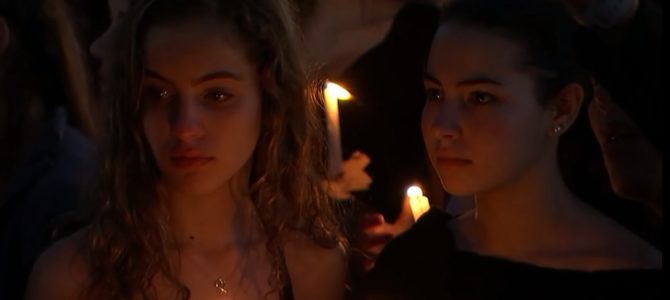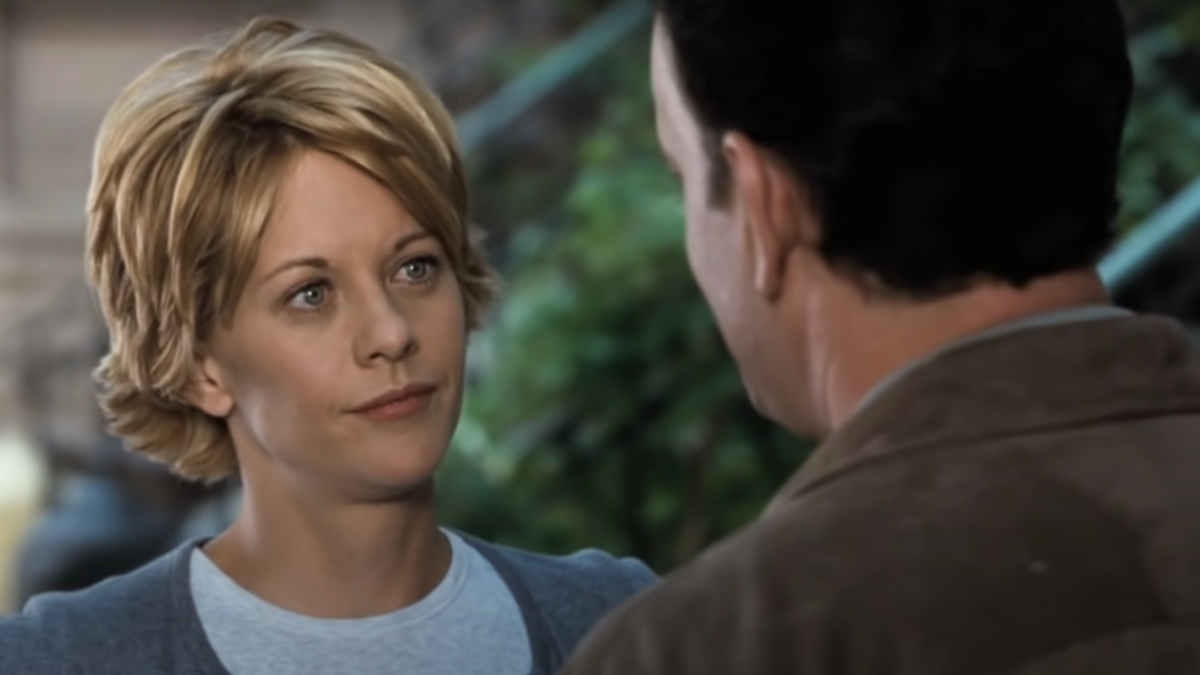
An Associated Press photo by Joel Auerbach is imprinted on my memory. It captures a scene from the mass murder in Parkland, Florida, where 17 students and teachers were killed last Wednesday.
This AP photo from the Parkland, Florida shooting is just… pic.twitter.com/dVgQtmw9yk
— Erick Fernandez (@ErickFernandez) February 14, 2018
Among a crowd of parents awaiting news of their kids, two women embrace. You can almost hear the red-haired woman with open mouth wailing in grief. Another holds her while choking back her own tears. Around the neck of the second woman is a silver heart locket. On her forehead is a cross of ashes.
Anyone who has ever worn the cross of Ash Wednesday can tell you at a glance what she had heard a couple hours before the picture was snapped: “Remember, O man, that you are dust; and unto dust you shall return.”
In this single photo, three events converge. The heart locket hangs in the center of the frame, suggesting St. Valentine’s Day, but romantic love is strangely out of place next to these women’s overwhelming grief. Above it all, as if giving meaning to the whole scene, are the ashes of repentance in the form of a cross.
Our Grief Breaks Open These Truths
Grief dominates the picture. There is no explaining it away. Even the most callous materialist, who has no earthly reason to be bothered by death, is horrified by it. People for the Ethical Treatment of Animals may argue that human life deserves no more respect than animal life. But such sophomoric rhetoric dissolves in the face of actual human tragedy. Human slaughter is different than animal slaughter, and we know it.
Darwinism implies that people are mere cosmic accidents, with no meaning or purpose. Even more, Darwinism teaches that the violent death of our forebears is the happy reason we have progressed to our current evolutionary state. For more than 150 years we have been told that death is our friend and ally. So why should 17 more grieve us?
But they do grieve us, and no one escapes it. In an instant, everyone can perceive Darwin’s lie. The deaths of students Alyssa Alhadeff, Martin Anguiano, Jaime Guttenberg, Cara Loughran, Gina Montalto, Alaina Petty, Alex Schachter, Luke Hoyer, Peter Wang, Carmen Schentrup, Nicholas Dworet, Joaquin Oliver, Helena Ramsay, Meadow Pollack, and teachers Scott Beigel, Aaron Feis, and Chris Hixon, have not made us a better race. We are the poorer for it.
Don’t Divide Our Unity Around Truth
In fact, human death evokes such a powerful loathing that we are tempted to harness it to advance our selfish agendas. CNN broke the news at 2:39 p.m. Within minutes, partisan political memes were pasted on social media. Seventeen victims became mere props to advance gun control, mental health spending, pharmaceutical responsibility, or just to bash the opposing party.
That’s a shame. The universal hatred of human death is a unifying force. Let’s not use it to divide. Instead, let’s take some time to rejoice that there is common ground upon which we all can agree. Then let’s see if recognizing that common ground might help us build a common foundation.
When people die, we instinctively know that something is wrong. Before we start beating each other up about a thousand policy squabbles, we should simply let those words sink in. “Something is wrong.” That is a singular noun, not plural. Somewhere, at the root of it all, lies a singular problem.
Does anybody really believe that having a perfect health system will fix it? Does anybody really believe that a world with no guns would be a world in which nothing is wrong? If we were all armed to the teeth, would the world be all sunshine and roses? Of course not!
The only way you could claim these to be even marginal improvements on the world is if you could show that they contributed to fixing that one thing at the root of it all. So, again, what is the one thing that would cure the whole world?
A Specific Kind of Love
John Lennon thought, “All you need is love.” By that, he meant romantic love. So he left his wife, Cynthia, and his son, Julian, to take up with Yoko Ono. All three of them needed love. But one sought it at the expense of two others.
Here is Valentine’s Day gone awry. “Be mine forever” dissolves into a hookup culture. The vow, “’til death us do part,” becomes a lie, and the promised cure-all becomes a fraud.
Nikolas Cruz was conceived in romantic love, too. But those parents did not continue loving him. By the time he was about a year old, he and his younger brother were adopted by Lynda and Roger Cruz. One bond of love was broken, and he and Zachary were forced to form a new bond.
Then, when he was only six, Cruz’s new father died of a sudden heart attack. His stay-at-home mom had to leave the home to put bread on the table. Thirteen years later, in November 2017, Lynda died suddenly of flu complications, and once again, he was without family.
I am not claiming that Ash Wednesday’s tragedy was caused by a broken home. Countless children endure similar troubles and don’t respond with mass murder. Perhaps psych drugs, video games, or being bullied contributed to his decision to kill the innocent. The only point I am making is that love failed him. Something stronger is needed than a flutter in the heart. Valentine hearts are a good start, but what’s really needed is an examination of our own hearts.
The Root Cause of Our Hatred
Even the lack of love in this world is not the root cause, but only a symptom. The root cause is sin. Ultimately, the problem with our hearts is not what others do to them. The problem is what is inside of them.
Aleksandr Solzhenitsyn wrote, “If only it were all so simple! If only there were evil people somewhere insidiously committing evil deeds, and it were necessary only to separate them from the rest of us and destroy them. But the line dividing good and evil cuts through the heart of every human being. And who is willing to destroy a piece of his own heart?”
But destroy it we must. It is the only path to sanity, the only cure for what ails us. What’s wrong with us? We are.
That basic insight is the meaning of the cross of Ash Wednesday. The ashes remind us that we are destined to die, but they do so without diminishing the horror of death. They also mean repentance. If we were to spend even half as much time examining our own moral failings as we do examining the sins of others, we would all be better off.
But the death and repentance of the ashes are reformed into the shape of a cross. That cross makes everything right. It is the symbol of one who neither approves of evil, nor hates the evildoer. The cross is about the One who dies that you might live.
Assistant coach Aaron Feis, geography teacher Scott Beigel, Athletic Director Chris Hixon, and ROTC student Peter Wang became living examples of Jesus last Wednesday. All three teachers sacrificed themselves for their students. That’s stronger than the Valentine kind of love. It’s the Ash Wednesday kind.









